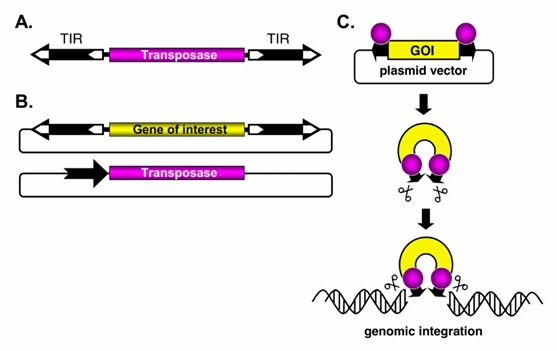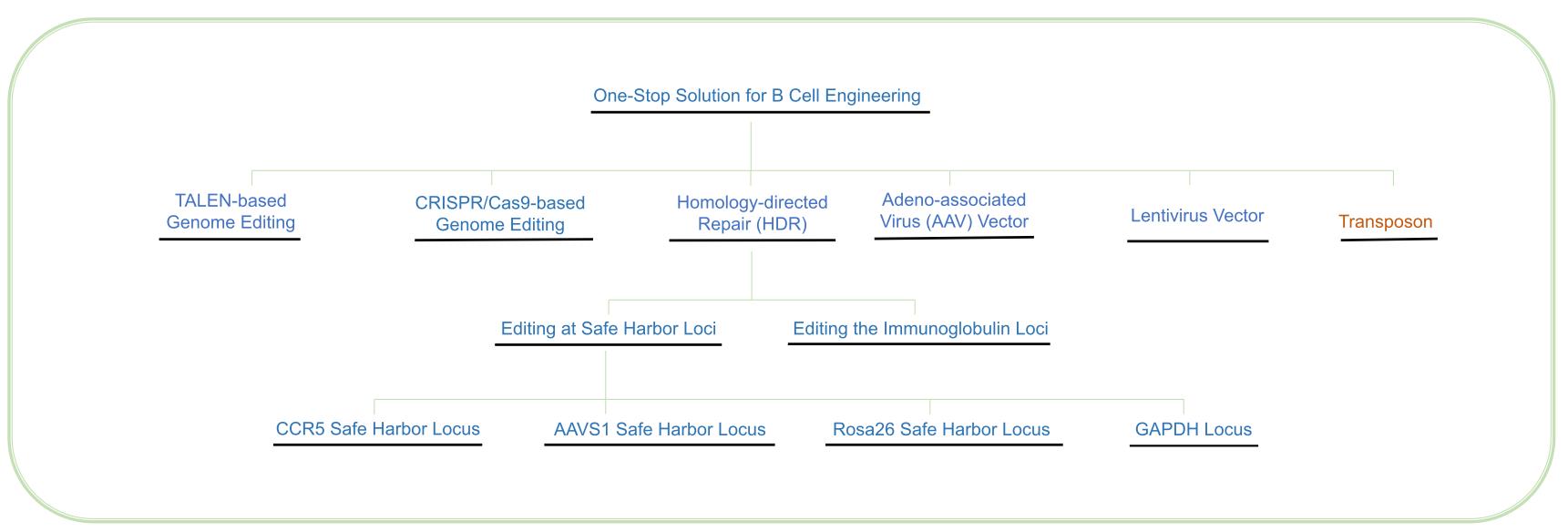Transposable elements, known as DNA transposons, can act as natural carriers of DNA, similar to integrating viruses, allowing for efficient insertion into the genome. This method has provided numerous opportunities for manipulating the genome.
 Fig.1 General organization and application of class ii transposable elements as gene carriers.1
Fig.1 General organization and application of class ii transposable elements as gene carriers.1
B cells present distinctive prospects for gene therapy due to their capacity to release substantial quantities of protein in the form of antibodies and endure as plasma cells throughout the organism's lifespan. CRISPR/Cas9, Transcription Activator-like Effector Nucleases (TALEN), Homology-directed Repair (HDR), Adeno-associated Virus (AAV) Vector, and Lentivirus Vector, and transposon can be utilized to integrate a transgene of interest into the genome of B cells.
Improving the transpositional activity has been a primary goal in the development of transposon vectors. Creative Biolabs has developed hyperactive transposon systems with almost every single amino acid in the SB transposase changed. To enhance transpositional activities, we employ various strategies such as importing amino acids and small segments of amino acids from transposases that are related, conducting systematic alanine scanning, and selectively replacing specific amino acid residues using a rational approach.
Key features of our hyperactive transposon systems:
- Integration site preference.
- Numerous landing sites to initiate transposition out of different loci.
Transposon-engineered B cells have the potential to generate large quantities of monoclonal antibodies (mAb) and innovative cell-based proteins on an industrial scale. On the other hand, utilizing genetically engineered B cells can contribute to a better comprehension of B cell functionalities and fundamental biology.
 Fig. 2 Our one-stop solution for B cell engineering.
Fig. 2 Our one-stop solution for B cell engineering.
Technology: Transposon-based genome editing
Journal: Human gene therapy
IF: 4.2
Published: 2017
Background & Results: Transposons have emerged as a potential solution for gene therapy, offering advantages over viral vectors. Transposons facilitate the long-term expression of therapeutic genes by incorporating themselves into the genome of the target cell. What once started as basic tools in biomedical research, transposons have now become established therapeutics. At present, the most encouraging transposons for gene therapy are sourced from the Sleeping Beauty (SB) or piggyBac (PB) elements. To enhance stable transposition efficiency, newer transposon systems utilize codon optimization and hyper-activating mutations in SB or PB transposases.
The ease of isolating B cells from peripheral blood, their fast growth, and their potential to transform into long-lived plasma cells that produce abundant mAbs or proteins make them an appealing option for gene therapy. B cells engineered by transposon provide a fresh opportunity to utilize them in the treatment of diverse diseases and to explore their fundamental biology within a human framework.
A: Transposon editing involves the use of specialized enzymes, such as Transposase, which can recognize and cut transposons at specific DNA sequences. By engineering these transposases, researchers can direct them to target and insert desired genetic modifications at particular locations in the genome.
A: Transposon editing has a wide range of applications in cell biology and genetic engineering. It can be used to study gene functionality, develop disease models, and advance cellular therapies.
Creative Biolabs offers professional consultation guidance for engineering B cells by transposon, please contact us for your tailored solution.